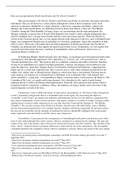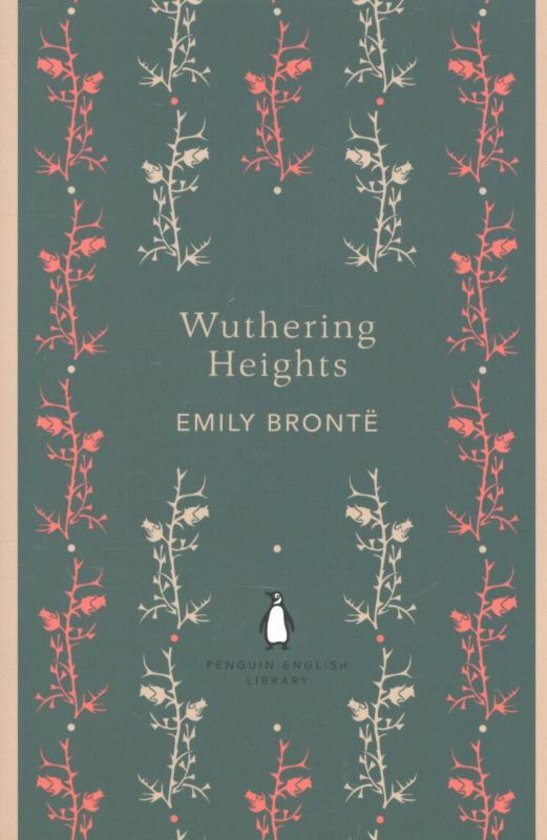How are men presented in Wuthering Heights and The Bloody Chamber?
Men are presented in The Bloody Chamber and Wuthering Heights as powerful, masculine and robust
individuals. They are all flawed to a certain degree although the extent of their corruption varies, from
character to character. Heathcliff, as a major character, is driven by vengeance and malice, whereas the
Marquis, the Count and the Beast, are ultimately driven by their erotic desires. Carter sets ‘The Bloody
Chamber’ during the Third Republic in France, hence, we can determine that the male protagonist, the
Marquis, embodies a typical man of French Third Republic who would’ve had a militant background, they
must be confident, have a strong sense of pride and have clear and concise speech.1 Wuthering Heights is
written in the Victorian period, thus, we can suggest that the male characters in the text, such as Heathcliff and
Edgar, are considered by Brontё to be an archetype of a Victorian ‘gentleman’, hence they should be of high
birth or status.2 This essay will explore how the male protagonists, in Wuthering Heights and The Bloody
Chamber, are portrayed and if they oppose the typical man of their set era. Furthermore, we will explore how
exercised masculine power becomes a medium of manipulation, abuse and betrayal, which serves as
significant themes in both texts.
In Wuthering Heights, Brontё presents men, like Edgar, as nonchalant and well-mannered which often
corresponds to their pleasant appearance. He is depicted as a ‘civilized’ and ‘well-mannered man’3 who is
“dressed and behaved as well”. This portrays him as a confident, courteous and selfless character; therefore,
he may be an embodiment of a typical Victorian gentleman. Likewise, the imagery used to define his eyes
using the adjectives ‘great blue’ propose that he is trustworthy, intellectual and judicious,4 suggesting that
Edgar may be a serene and composed man. He is scarcely seen as virile when situations demand him to be,
neither is he violent. Like so, Brontë portrays Edgar as a subversion from a conventional Victorian man in
some respects, for instance, he is characterised as effeminate as he is depicted with a ‘soft-featured face’
which resembles a ‘young lady’. Corresponding to Edgar’s courteous nature, Carter portrays the Beast in ‘The
Courtship of Mr Lyon’ as a gentle and loving character. He is described as the ‘spirit of good fortune’
implying that he is selfless and brings about righteousness. Ironically, this represents inner beauty which is
juxtaposed with his ‘monstrous’ semblance. Hence, the audience can expect similar traits from some of the
male protagonists in both of the texts.
Furthermore, Carter exhibits the theme of male power and authority in ‘The Snow Child’ through the
Count’s criminality and presents him as a formidable and vicious figure. By associating the adjective
‘invincible’ to the Count,5 accentuates his authority and dominance he has over his inferiors, suggesting that
the Count is indomitable. Power reveals a person’s true nature, whether it is noble or corrupt,6 bearing a noble
identity doesn’t result in noble character (as we can infer from the Count and the Marquis in ‘The Bloody
Chamber’). We can also assume, from Wuthering Heights, that the men with noble births, such as Hindley,
deviate from moral characteristics, for example, honesty, kindness and being responsible for personal actions.
He may not be invincible, but his attempts to dominate his inferior, Heathcliff, highlights that weak people
make a patriarch seem inevitably invincible, hence more dangerous.7
Nevertheless, Carter presents the consequences of unchallenged male power and portrays men with a
lack of self-control through the Count’s action, which is considered as criminal by the audience. He rapes the
corpse of the ‘girl of his desires’ due to the lack of satisfaction he gains from the Countess. The mention of the
noun, ‘desire’, indicates that his tyrannous behaviour is motivated by his erotic inclinations. The necrophilia
committed manifests his compulsive desire which is regarded as extreme. Hence, the moral of the story adopts
1 https://www.psychologytoday.com/us/blog/the-camouflage-couch/201107/is-there-military-personality Accessed 2nd
September 2019
2 https://www.dictionary.com/browse/gentleman Accessed 2nd May 2019
3 https://www.dictionary.com/browse/gentleman Accessed 2nd May 2019
4 www.slideshare.net/munpreet/colour-connotations-12023909 Accessed 3rd June 2019
5 https://www.thisishorror.co.uk/the-snow-child-angela-carter/ Accessed 27th May
2017
6 https://www.studymode.com/essays/The-Effects-Of-Power-On-Responsibility-141813.html Accessed 2nd May 2019
7 Roberts, Steve The Bloody Chamber: AS & A2 York Notes, (Pearson Education 2012)





